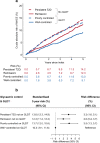Risk of first-time major cardiovascular event among individuals with newly diagnosed type 2 diabetes: data from Danish registers
- PMID: 37528178
- PMCID: PMC10541344
- DOI: 10.1007/s00125-023-05977-6
Risk of first-time major cardiovascular event among individuals with newly diagnosed type 2 diabetes: data from Danish registers
Abstract
Aims/hypothesis: We aimed to examine whether individuals with initial omission of glucose-lowering drug treatment (GLDT), including those achieving initial remission of type 2 diabetes, may experience a higher risk of major adverse cardiovascular events (MACE) compared with well-controlled individuals on GLDT after a new type 2 diabetes diagnosis in real-world clinical practice. Furthermore, we examined whether a higher risk could be related to lower initiation of statins and renin-angiotensin system inhibitors (RASi).
Methods: In this cohort study, we used Danish registers to identify individuals with a first measured HbA1c between 48 and 57 mmol/mol (6.5-7.4%) from 2014 to 2020. Six months later, we divided participants into four groups according to GLDT and achieved HbA1c (<48 vs ≥48 mmol/mol [6.5%]): well-controlled and poorly controlled on GLDT; remission and persistent type 2 diabetes not on GLDT. We reported how much the standardised 5 year risk of MACE could be reduced for each group if initiation of statins and RASi was the same as in the well-controlled group on GLDT.
Results: We included 14,221 individuals. Compared with well-controlled participants on GLDT, the 5 year standardised risk of MACE was higher in the three other exposure groups: by 3.3% (95% CI 1.6, 5.1) in the persistent type 2 diabetes group not on GLDT; 2.0% (95% CI 0.4, 3.7) in the remission group not on GLDT; and 3.5% (95% CI 1.3, 5.7) in the poorly controlled group on GLDT. Fewer individuals not on GLDT initiated statins and RASi compared with individuals on GLDT. If initiation of statins and RASi had been the same as in the well-controlled group on GLDT, participants not on GLDT could have reduced their risk of MACE by 2.1% (95% CI 1.2, 2.9) in the persistent type 2 diabetes group and by 1.1% (95% CI 0.4, 1.9) in the remission group.
Conclusions/interpretation: Compared with well-controlled individuals on GLDT, individuals not on initial GLDT had a higher 5 year risk of MACE, even among those achieving remission of type 2 diabetes. This may be related to lower use of statins and RASi.
Keywords: Cardiovascular disease; Glucose-lowering drug; Glycaemic control; Remission of type 2 diabetes; Renin–angiotensin system inhibitor; Statin; Type 2 diabetes.
© 2023. The Author(s).
Figures




Similar articles
-
Triglycerides and risk of cardiovascular events in statin-treated patients with newly diagnosed type 2 diabetes: a Danish cohort study.Cardiovasc Diabetol. 2023 Jul 26;22(1):187. doi: 10.1186/s12933-023-01921-5. Cardiovasc Diabetol. 2023. PMID: 37495999 Free PMC article.
-
Effects of background statin therapy on glycemic response and cardiovascular events following initiation of insulin therapy in type 2 diabetes: a large UK cohort study.Cardiovasc Diabetol. 2017 Aug 22;16(1):107. doi: 10.1186/s12933-017-0587-6. Cardiovasc Diabetol. 2017. PMID: 28830436 Free PMC article.
-
Early glycaemic changes after initiation of oral antidiabetic medication and risk of major adverse cardiovascular events: results from a large primary care population of patients with type 2 diabetes.Eur Heart J Cardiovasc Pharmacother. 2021 Nov 3;7(6):486-495. doi: 10.1093/ehjcvp/pvaa072. Eur Heart J Cardiovasc Pharmacother. 2021. PMID: 32614428
-
Cardiovascular outcomes associated with SGLT-2 inhibitors versus other glucose-lowering drugs in patients with type 2 diabetes: A real-world systematic review and meta-analysis.PLoS One. 2021 Feb 19;16(2):e0244689. doi: 10.1371/journal.pone.0244689. eCollection 2021. PLoS One. 2021. PMID: 33606705 Free PMC article.
-
Legacy effect of intensive glucose control on major adverse cardiovascular outcome: Systematic review and meta-analyses of trials according to different scenarios.Metabolism. 2020 Sep;110:154308. doi: 10.1016/j.metabol.2020.154308. Epub 2020 Jul 4. Metabolism. 2020. PMID: 32628943
Cited by
-
Good metabolic control is associated with decreased circulating factor VIIa- antithrombin complexes in type 2 diabetes: a cross-sectional study.Cardiovasc Diabetol. 2024 Nov 5;23(1):398. doi: 10.1186/s12933-024-02480-z. Cardiovasc Diabetol. 2024. PMID: 39501309 Free PMC article.
-
Current treatment guidelines and glycated haemoglobin goals for type 2 diabetes: Which patients are most likely to benefit from fixed-ratio basal insulin glucagon-like peptide-1 receptor agonist combinations?Diabetes Obes Metab. 2025 Aug;27 Suppl 7(Suppl 7):3-13. doi: 10.1111/dom.16502. Epub 2025 Jun 11. Diabetes Obes Metab. 2025. PMID: 40497353 Free PMC article. Review.
-
A service evaluation of weight management for glycaemic control and remission of type 2 diabetes using traditional food in Nepal (Ho-DIRECT NEPAL): a single-arm trial.Lancet Reg Health Southeast Asia. 2024 Aug 17;29:100465. doi: 10.1016/j.lansea.2024.100465. eCollection 2024 Oct. Lancet Reg Health Southeast Asia. 2024. PMID: 39253354 Free PMC article.
References
-
- Inzucchi SE, Bergenstal RM, Buse JB, et al. Management of hyperglycaemia in type 2 diabetes: a patient-centered approach. Position statement of the American Diabetes Association (ADA) and the European Association for the Study of Diabetes (EASD) Diabetologia. 2012;55:1577–1596. doi: 10.1007/s00125-012-2534-0. - DOI - PubMed
-
- Danish Society for General Practice and Danish Endocrine Society (2014) Pharmacological treatment of type 2 diabetes - aims and algorithms 2014. Available from https://endocrinology.dk/PDF/FarmakologiskbehandlingDM2rev2014.pdf. Accessed 21 October 2022
-
- Danish Society for General Practice and Danish Endocrine Society (2018) Pharmacological treatment of type 2 diabetes - aims and algorithms 2018. Available from https://vejledninger.dsam.dk/media/files/4/guidelines-2018-final.pdf. Accessed 21 October 2022
Publication types
MeSH terms
Substances
LinkOut - more resources
Full Text Sources
Medical
Miscellaneous

